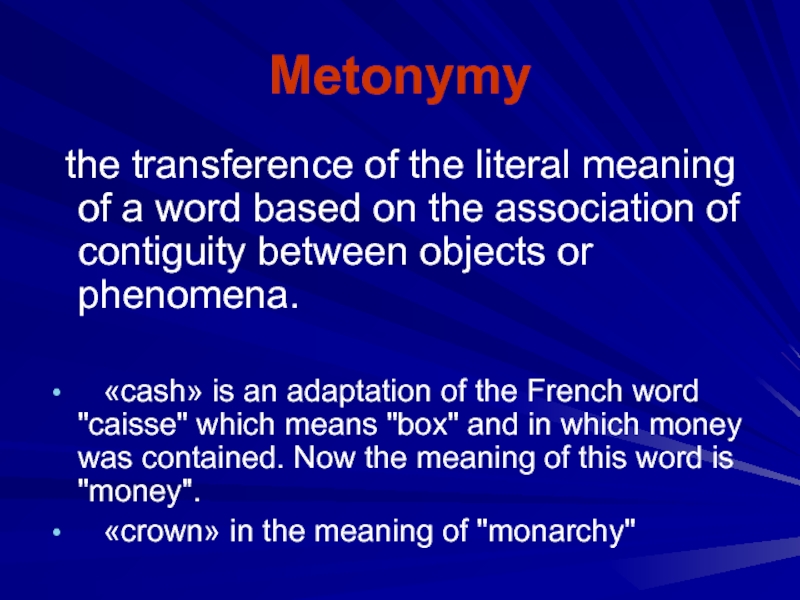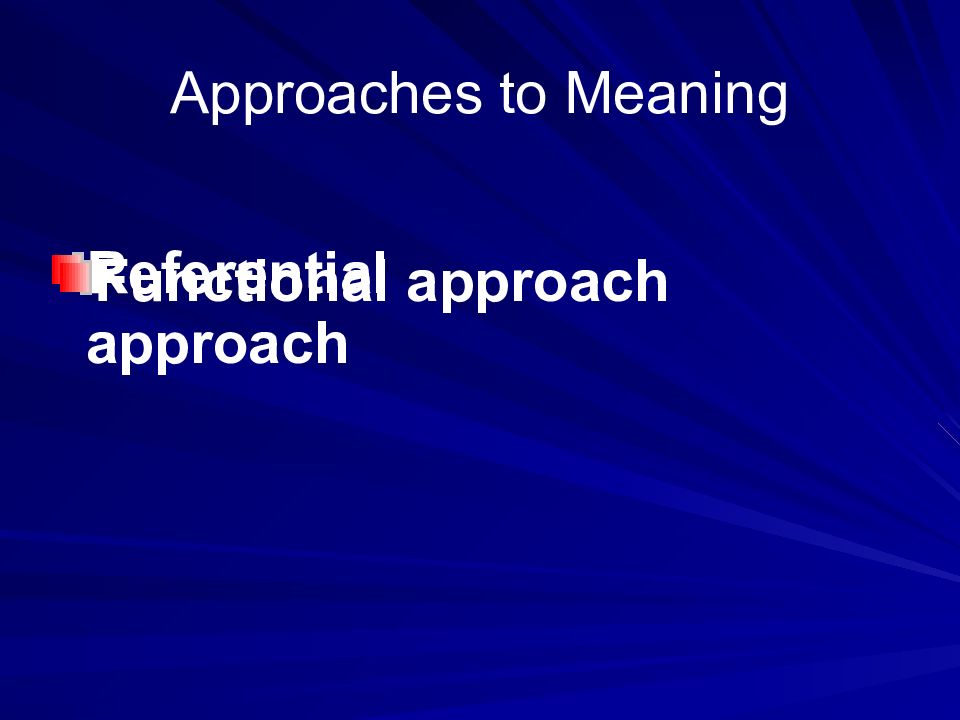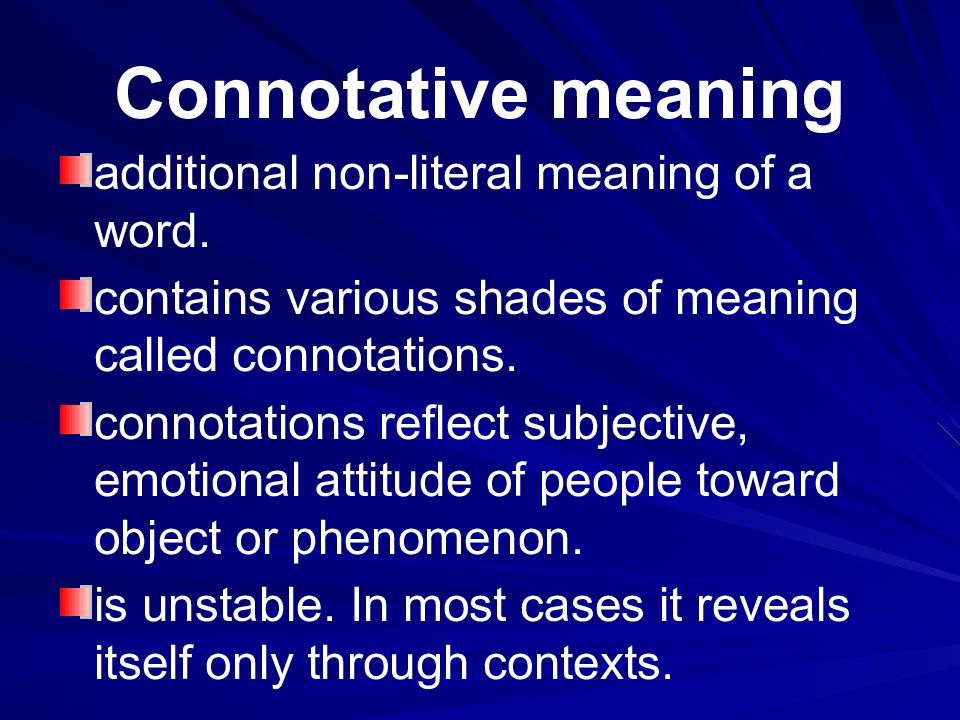17. Types of meaning. Semantic structure
of the word.
Types of meaning
Типы значений
There are two main types of meaning:
1) the grammatical meaning,
2. the lexical meaning.
Есть два основных типа значения:
1) грамматический смысл,
2. лексический смысл.
1. The grammatical meaning is the formal meaning of a word. It is
defined as the meaning belonging to the lexico-grammatical classes and
grammatical categories. It is expressed by the word’s form. Every word
belongs to a definite part of speech and every part of speech has a certain
grammatical categories. E.g. verbs have tense, voice, mood, person etc. Nouns
have the categories of case, number etc. E.g. the words “asked”, “thought”,
“talked”, “took, ran” have the grammatical meaning of tense. The grammatical
meaning unites words into big groups such as parts of speech.
1.Грамматический смысл — это формальный смысл слова.
Он определяется как значение, относящееся к лексико-грамматическим классам и
грамматическим категориям. Это выражается формой слова. Каждое слово
принадлежит определенной части речи, и каждая часть речи имеет определенные
грамматические категории. Ex. Глаголы имеют напряженный,
голос, настроение, лицо и т. Д. Существительные имеют категории случаев,
число и т. Д. Пример. Слова «спросили», «подумали», «поговорили», «взяли,
побежали», имеют грамматический смысл времени. Грамматический смысл
объединяет слова в большие группы, такие как части речи
2. The lexical meaning is the material meaning of a word. This is
a meaning which gives the concept of a word. By the lexical meaning the word
expresses the basic properties of the thing the word denotes.
2.Лексический смысл — это
материальный смысл слова. Это значение, которое дает понятие слова. По
лексическому значению слово выражает основные свойства вещи, которую
обозначает слово.
The lexical meaning of a word falls into two:
1) the denotational meaning,
2) the connotational meaning.
Denotational meaning makes communication
possible because words denote things, concepts, they name them.
E.g. the denotational meaning of the word
“table” is a piece of furniture consisting of a flat top with four supports
(called legs).
The denotational meaning is associated with
emotions (e.g. He besought a favour of the judge: Here the word “beseech”
means “to ask eagerly and also anxiously”). Evaluative connotation denotes
approval or disapproval relations to the thing or phenomena,
E.g. colt, a young male horse used for a young
inexperienced person; pup- a young dog used for a person. These words have
negative evaluation.
But in English we have words which have positive
evaluation (ex. bunny — кролик, bunting-лапочка).
Intensifying connotation is the reinforcement of
the sign: it indicates the special importance of the thing expressed. E.g.
awfully glad, terribly important.
Лексический смысл слова делится на два:
1) денотационный смысл,
2) коннотационный смысл.
Денотационный смысл делает общение
возможным, потому что слова обозначают вещи, понятия, они называют их.
Ex. Денотационный смысл слова «стол» —
это предмет мебели, состоящий из плоской вершины с четырьмя опорами
(называемых ногами).
Денотационный смысл связан с эмоциями
(например, он просил о помощи судьи: здесь слово «умолять» означает «спросить
с нетерпением, а также с тревогой»). Оценочная коннотация означает одобрение
или неодобрение отношений с вещью или явлениями, например.
Colt — молодой мужской конь,
используемый для молодого неопытного человека; Pup — молодая собака,
используемая для человека. Эти слова имеют отрицательную оценку.
Но на английском языке мы имеем слова,
которые имеют положительную оценку (например, кролик — кролик,
bunting-лапочка.
Усиление связи — это усиление знака: оно
указывает на особую важность выраженной вещи. Ex. Ужасно рад, ужасно важно
The connotational meaning is
a meaning which has a stylistic shade. It serves to express all sorts of
emotions, expressiveness. Connotation may be shortly defined as emotional and
evaluative component of the lexical meaning, Comparing the meanings of
English words “well-known”, “famous”, “notorious” we see that all these words
express the denotational meaning “widely known”. But the word “famous” has a
positive evaluative meaning and “notorious has a negative evaluation. So, the
words “well-known”, “famous”, “notorious” differ in their emotional colouring
and evaluation.
The connotational meaning may be expressed also
either in the emotive charge or in stylistic reference.
E.g. “aunt” and “auntie”. These words have the
same denotational meaning but the word “aunt” has no emotive charge but
“auntie” has it.
Коннотационный смысл — это значение,
имеющее стилистический оттенок. Он служит для выражения всех видов эмоций,
выразительности. Коннотация может быть коротко определена как эмоциональная и
оценочная составляющая лексического значения. Сравнивая значения английских
слов «хорошо известные», «знаменитые», «печально известные», мы видим, что
все эти слова выражают денотационное значение «широко известно». Но слово
«знаменитый» имеет положительный оценочный смысл, а «печально известная»
отрицательная оценка. Итак, слова «хорошо известны», «знаменитые», «печально
известные» отличаются своей эмоциональной окраской и оценкой.
Коннотационный смысл может быть выражен либо в
эмоциональном заряде, либо в стилистической ссылке.
Ex. «Тетя» и «тетушка». Эти слова имеют
одинаковый денотационный смысл, но слово «тетя» не имеет эмоционального
заряда, но «тетушка» имеет его.
Stylistically words can be subdivided into literary,
neutral and colloquial
layers.
Neutral words are words of
general use. E.g. the words “to begin” (начинать) and “to commence”(начинать) “dad”
and “ father” have the same denotational meanings but “to begin” and “father”
are stylistically neutral words, whereas “dad” is a colloquial word and “ to
commence” stylistically is a literary word.
Стилистически
слова можно подразделить на
литературные,
нейтральные и
разговорные слои.
Нейтральные слова —
это слова общего пользования. Ex. Слова «начать» (начинать) и «начать»
(начинать) «папа» и «отец» имеют одинаковые денотационные значения, но
«начать» и «отец» являются стилистически нейтральными словами, тогда как
«папа» — это разговорный Слово и «начать» стилистически — это литературное
слово.
Besides the lexical and grammatical meanings we
can observe
differential,
functional and
distributional meanings of a word.
Differential meaning is the semantic component
that serves to distinguish one word from other in words containing the same (identical)
morphemes.
E.g. “note-book”. The morpheme “note” serves to
distinguish the word from other words: exercise-book, copy-book or:
bookshelf, bookcase.
The functional meaning may be seen in derivational
morphemes. If we see words with the suffixes -ment, -er, -ity, -or, we say
that they are nouns.
E.g. establishment, plurality, teacher,
translator, sailor.
If -ful, -less, -able, -al etc. are present in
words we say adjectives.
E.g. helpful, handless, guiltless, readable,
national, writable, operational, openable, proposal.
The distributional meaning is found in all words
having more than one morpheme. It is found in the arrangement and order of
morphemes making up the word.
E.g. “teacher” but not *erteach.
“boyishness”
but not *nessboyish.
Помимо лексических и грамматических
значений, мы можем наблюдать
дифференциальные,
функциональные и
распределительные значения слова.
Дифференциальное значение — это
семантическая составляющая, которая служит для того, чтобы отличить одно
слово от другого в словах, содержащих одни и те же (зубные) морфемы.
Ex. «блокнот». Морфема
«примечание» служит для того, чтобы отличить слово от
Другими словами: тетрадь, тетрадь или
книжная полка, книжный шкаф.
Функциональное значение можно увидеть в
деривационных морфемах. Если мы видим слова с суффиксом, -er, -ity, -или, мы
говорим, что они существительные.
Например. Создание, множественность,
учитель, переводчик, матрос.
If -ful, -less, -able, -al и т. Д.
Присутствуют в словах, мы говорим прилагательные.
Ex. Полезный, бесшумный, невинный,
читаемый, национальный, доступный для записи, операционный, открываемый,
предложение.
Значение распределения содержится во
всех словах, имеющих более одной морфемы. Он находится в расположении и
порядке морфем, составляющих слово.
Ex. «Учитель», но не * erteach.
«Боязливость», но не
* nessboyish.
Different types of the lexical meaning of one and the same word
are considered its lexico-semantic variants. Lexico-semantic variants in
their correlations and interconnection form the semantic structure of the
word. In the semantic structure of the word there is special information on
the members and the conditions of communication. The intercourse and personal
contacts in real situations may reveal the pragmatic aspect of the lexical
meaning of the word.
E.g. “Hello” is used in unofficial situations giving a signal at
the same time to the friendly relations of the members of the communication.
Различные лексические значения одного и того же слова считаются
его лексико-семантическими вариантами. Лексико-семантические варианты в их
корреляциях и взаимосвязи образуют семантическую структуру слова. В
семантической структуре слова есть специальная информация о членах и условиях
общения. Взаимоотношения и личные контакты в реальных ситуациях могут выявить
прагматический аспект лексического значения слова.
Ex. «Hallo» используется в неофициальных ситуациях, давая сигнал
в то же время к дружеским отношениям членов сообщения.
Semantic
structure of the word.
The semantic structure of the word. Types of lexical meaning.
The branch of Linguistics which studies the meaning of different
linguistic units is called Semantics. The part of Lexicology which studies
the meaning and the development of meaning of words is called Semasiology.
There are different approaches to the problem of word meaning:
1) The referential, or denotational approach is characterised by
the thought that (тем что) the essence (суть) of meaning lies in the
interconnection and interdependence between: the word as the sound form, the
referent, and the concept. Here meaning is the realisation of the
concept/notion by means of a definite language system.
2) The functional, or contextual approach is characterised by
the idea that the meaning of a linguistic unit may be studied only through
its relation to other linguistic units. Thus, meaning is understood as the
function of linguistic signs, or their use in context.
Word meaning is represented by different types of meaning:
grammatical, lexical, lexico-grammatical.
Grammatical meaning is the component of word meaning, recurrent
in identical sets of individual forms of different words. It is expressed by:
word-form (such as books, girls, boys – the meaning of plurality;
looked, asked – tense meaning);
The position of the word in relation to other words (e.g. He
sings well, She dances badly – ‘sings’ and ‘dances’ are found in identical
positions between a pronoun and an adverb, their identical distribution
proves that they have identical gr.m.)
Lexico-grammatical meaning of the word is the common denominator
(знаменатель) to all the meanings of the words belonging to a certain
lexico-grammatical class or group of words.
Lexical meaning is the component of word meaning recurrent in
all the forms of the word. The word forms go, goes, went, gone, going have
different gr.m., but they have one and the same l.m. ‘the process of
movement’.
The main component of L.m. are: the denotational meaning of
words is the same for all the speakers. It is the realisation of the concept
by means of the given language.
Семантическая структура слова. Типы лексического значения.
Филиал Лингвистики, изучающий значение различных языковых
единиц, называется семантикой. Часть Лексикологии, которая изучает смысл и
развитие смысла слов, называется Семасиология.
Существуют различные подходы к проблеме смыслового значения:
1) ссылочный или денотационный подход характеризуется мыслью,
что (тем что) суть (суть) смысла заключается в взаимосвязи и
взаимозависимости между: словом как звуковой формой, Референт и концепция.
Здесь смысл заключается в реализации понятия / понятия с помощью определенной
языковой системы.
2) Функциональный или контекстуальный подход характеризуется
тем, что значение лингвистической единицы может изучаться только через ее
связь с другими лингвистическими единицами. Таким образом, смысл понимается
как функция лингвистических знаков или их использование в контексте.
Значение слова представлено различными типами значений:
грамматическим, лексическим, лексико-грамматическим.
Грамматический смысл — это компонент значения слова,
повторяющийся в идентичных наборах отдельных форм разных слов. Это
выражается:
Слово-форма (например, книги, девочки, мальчики — значение
плюрализма, взгляд, заданное значение);
Положение слова по отношению к другим словам (например, он поет хорошо,
она плохо танцует — «поющие» и «танцы» находятся в одинаковых положениях
между местоимением и наречием, их идентичное распределение доказывает, что
они имеют одинаковые грамм .)
Лексико-грамматический смысл слова является общим знаменателем
(знаменатель) ко всем значениям слов, относящихся к определенному
лексико-грамматическому классу или группе слов.
Лексическое значение — это компонент слова, повторяющийся во
всех формах слова. Слово «формы» уходит, уходит, уходит, уходит, уходит
разное gr.m., но у них одно и то же l.m. «Процесс движения».
Основной компонент L.m. находятся: Денотационный смысл слов для всех динамиков
одинаковый. Это реализация концепции с помощью данного языка
The pragmatic aspect is the part of the meaning, that conveys information
on the situation of communication: information on the ‘time and space’
relationship of the participants, information on the participants in the
given language community, information on the register of communication.
The connotational meaning conveys the speaker’s attitude toward
what he is speaking about. There are 4 main types of connotations: a) The
emotional connotation expresses human emotions and feelings (e.g. daddy,
father); b) The evaluative connotation expresses approval or disapproval (e.g.
agent and spy, planning and scheming=planning secretly); c) The intensifying
connotation adds emphasis (усиление) to
the meaning. (e.g. enormous, huge, tremendous=very large); d) The stylistic
connotation determines the functional speech style characteristic of the word
usage (dad-father-parent; colloquial-neutral-bookish).
Прагматический аспект Является частью смысла, которая передает
информацию о ситуации коммуникации: информацию о взаимоотношениях участников
«времени и пространства», информацию об участниках данного языкового
сообщества, информацию о реестре сообщений.
Коннотационный смысл передает отношение говорящего к тому, о чем
он говорит. Существует четыре основных типа коннотаций: а) эмоциональная
коннотация выражает человеческие эмоции и чувства (например, папа, отец); Б)
оценочная коннотация выражает утверждение или неодобрение (например, агент и
шпион, планирование и интриги = планирование тайно); В) Усиление коннотации
добавляет акцент (усиление) на смысл. (Например, огромные, огромные, огромные
= очень); D) Стилистическая коннотация определяет функциональный стиль речи,
характерный для использования слова (отец-отец-родитель,
разговорный-нейтральный-книжный).
Semasiology — the branch of linguistics concerned with the meaning of words and word equivalents.
(Greek) semasia — signification (значение, смысл) and logos — learning.
Изображение слайда
2
Слайд 2: The main objects of semasiological study:
types of lexical meaning
polysemy and semantic structure of words
semantic development of words
the main tendencies of the change of word-meanings
semantic grouping in the vocabulary system (synonyms, antonyms)
semantic fields
Изображение слайда
3
Слайд 3: Approaches to Meaning
Referential approach
Functional approach
Изображение слайда
4
Слайд 4: Referential approach to meaning
The meaning is in some form or other connected with the referent (object of reality denoted by the word).
The meaning is formulated by establishing the interdependence between words and objects of reality they denote.
The meaning is often understood as an object or phenomenon in the outside world that is referred to by a word.
Изображение слайда
5
Слайд 5: Functional approach to meaning
Words are studied in context; a word is defined by its functioning within phrase or a sentence.
The meaning of linguistic unit is studied only through its relation to other linguistic units.
The meaning is viewed as the function of a word in speech.
Изображение слайда
a category of human cognition (понятие, идея; общее представление; концепция).
the thought of the object that singles out the most typical, the most essential features of the object.
Изображение слайда
7
Слайд 7: the concept of » a building for human habitation »
English
house
«fixed residence of family or household» −
home
Ukrainian
дім
домівк a
Изображение слайда
8
Слайд 8: The difference between meaning and concept:
Concepts are always emotionally neutral
Meaning of many words not only conveys some reflection of objective reality but also the speaker’s attitude to what he is speaking about, his state of mind.
The concept of size: big / large / tremendous
Изображение слайда
(thought or reference)
Concept
Word —————— Referent
(symbol) (object denoted
by the word)
Изображение слайда
10
Слайд 10: The branch of linguistics which specializes in the study of meaning is called semantics
Meaning is a certain reflection in our mind of objects, phenomena or relations that makes part of the linguistic sign − its so-called inner facet (аспект, грань, сторона), whereas the sound-form functions as its outer facet.
Изображение слайда
11
Слайд 11: grammatical and lexical meanings
Grammatical meaning − the expression in speech the relationships between words.
Lexical meaning − the realization of concept or emotion by means of a definite language system.
Изображение слайда
12
Слайд 12: three types of lexical meaning of words:
1. Nominative meaning determined by reality. The direct nominative meaning stands in one-to-one relationship with a word. cat, table, sun
2. Phraseologically bound meaning of words depending on the peculiarities of their usage in a given language, e.g. to take care, to have a smoke, to catch a cold.
Изображение слайда
3. Syntactically conditioned meanings
of words are those which change with the change of the environment. Compare the following verbs:
«to look» — to look for— to look after
Изображение слайда
14
Слайд 14: The structure of lexical meaning of a word
denotative meaning
connotative meaning
Изображение слайда
15
Слайд 15: Denotative meaning
a linguistic expression for a concept or a name for an individual object.
makes communication possible.
is bound up with its referent.
may have one constant referent – a moon
may have several referents — a hand
Изображение слайда
16
Слайд 16: Connotative meaning
additional non-literal meaning of a word.
contains various shades of meaning called connotations.
connotations reflect subjective, emotional attitude of people toward object or phenomenon.
is unstable. In most cases it reveals itself only through contexts.
Изображение слайда
17
Слайд 17: four main types of connotations:
stylistic connotation is what the word conveys about the speaker’s attitude to the social circumstances and the appropriate functional style ( slay vs kill )
emotional connotation conveys the speaker’s emotions ( mummy vs mother )
Изображение слайда
evaluative connotation may show his approval or disapproval of the object spoken of ( clique vs group )
expressive/intensifying connotation is conveyed by degree of intensity (adore vs love)
Изображение слайда
the denotative component of the lexical meaning of the word is «frightening“.
the expressive or intensifying connotation is «very, very good» or «very great»:
terrific beauty, terrific pleasure
Изображение слайда
It is the connotative meaning in a word which helps create irony, sarcasm, metaphor and other figures of speech.
Изображение слайда
the ability of words to have more than one meaning.
A word having several meanings is called polysemantic and most English words are like this.
Изображение слайда
1) a flat horizontal slab or board, usually supported by one or more legs, on which objects may be placed
2) a) such a slab or board on which food is served we were six at table b) (as modifier) table linen c) (in combination) a tablecloth
3) food as served in a particular household or restaurant
4) such a piece of furniture specially designed for any of various purposes
5) a) a company of persons assembled for a meal, game, etc b) (as modifier) table talk
6) any flat or level area, such as a plateau
7) a rectangular panel set below or above the face of a wall

9) an upper horizontal facet of a cut gem
10) music the sounding board of a violin, guitar, or similar stringed instrument
Изображение слайда
23
Слайд 23: Change of lexical meaning in words
linguistic
— the influence of linguistic environment
— analogy
— the context
extra-linguistic
— cultural
— social
— psychological
Изображение слайда
24
Слайд 24: ways of change of word-meaning:
1. extension of meaning (generalization);
2. narrowing of meaning (specialization);
3. transference of meaning (metaphor and metonymy);
4. elevation of meaning (amelioration);
5. degradation of meaning (pejoration).
Изображение слайда
25
Слайд 25: 1. Extension /expanding of meaning (or generalization)
In the process of extension a word-meaning may acquire a higher degree of abstraction or more generalized character.
“manuscript” originally meant only something handwritten. Now it refers to any copy either written by hand or printed.
Изображение слайда
26
Слайд 26: 2. Narrowing of meaning/contraction, (specialization)
In the process of narrowing, a word-meaning acquires a specialized sense in which it is applicable only to some of the objects or phenomena it previously denoted.
a corpse — a human or animal body, living or dead. Now this word has been specialized to mean «a dead body», usually that of a human being.
Изображение слайда
27
Слайд 27: 3. Elevation of meaning ( amelioration )
In the process of elevation a word acquires the meaning of a greater importance than its original meaning.
marshal — originally meant a horse servant, now its meaning is «an officer of the highest rank»
Изображение слайда
28
Слайд 28: 4. Degradation of Meaning (degeneration, pejoration)
In the process of pejoration the word acquires unfavourable connotations or falls into disrepute.
«vulgar» — originally meant «common, ordinary»;
«gossip» — originally meant «a god parent»;
«silly» — originally meant «happy».
Изображение слайда
29
Слайд 29: 5. Transference of meaning
Transference of meaning takes place when the figures of speech are used.
Figures of speech are expressive means and stylistic devices such as metaphor and metonymy.
Изображение слайда
the transference of the literal meaning in a word based on the association of similarity between the objects or phenomena.
a woman can be called «a peach» if she is young and beautiful, or « a lemon » if she is ugly and boring.
Изображение слайда
31
Последний слайд презентации: Word meaning and its structure: Metonymy
the transference of the literal meaning of a word based on the association of contiguity between objects or phenomena.
«cash» is an adaptation of the French word «caisse» which means «box» and in which money was contained. Now the meaning of this word is «money».
«crown» in the meaning of «monarchy»
Изображение слайда
Слайд 1
Word meaning and its structure
Semasiology —
the branch of linguistics concerned with the meaning of words
and word equivalents.
(Greek) semasia — signification (значение, смысл) and logos — learning.
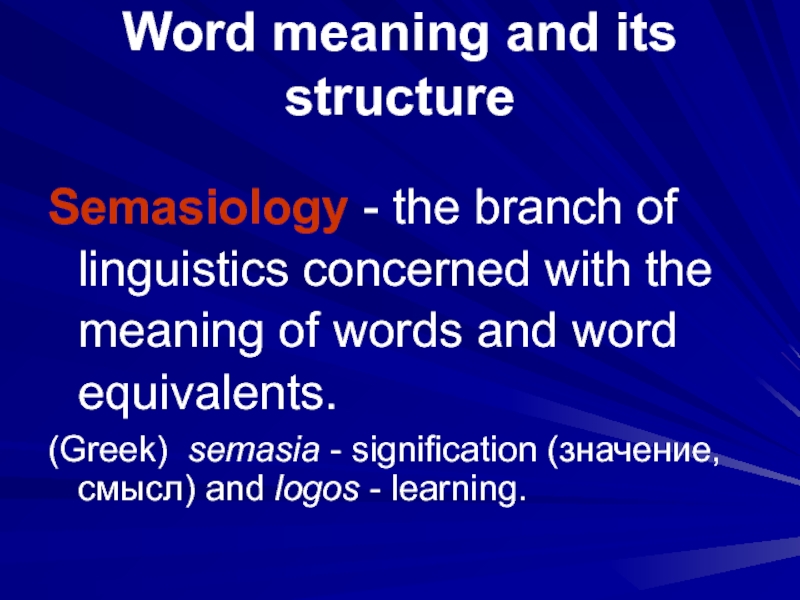
Слайд 2The main objects of semasiological study:
types of lexical meaning
polysemy
and semantic structure of words
semantic development of words
the main tendencies
of the change of word-meanings
semantic grouping in the vocabulary system (synonyms, antonyms)
semantic fields
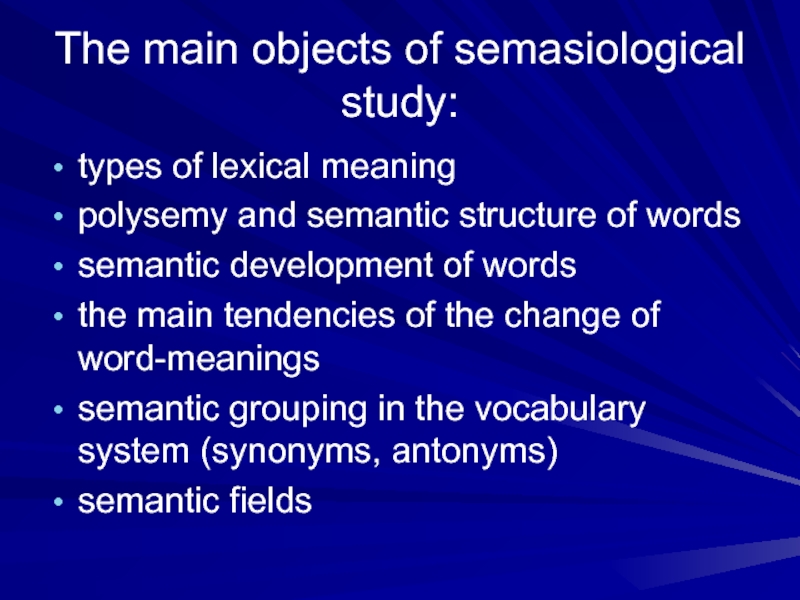
Слайд 3Approaches to Meaning
Referential approach
Functional approach
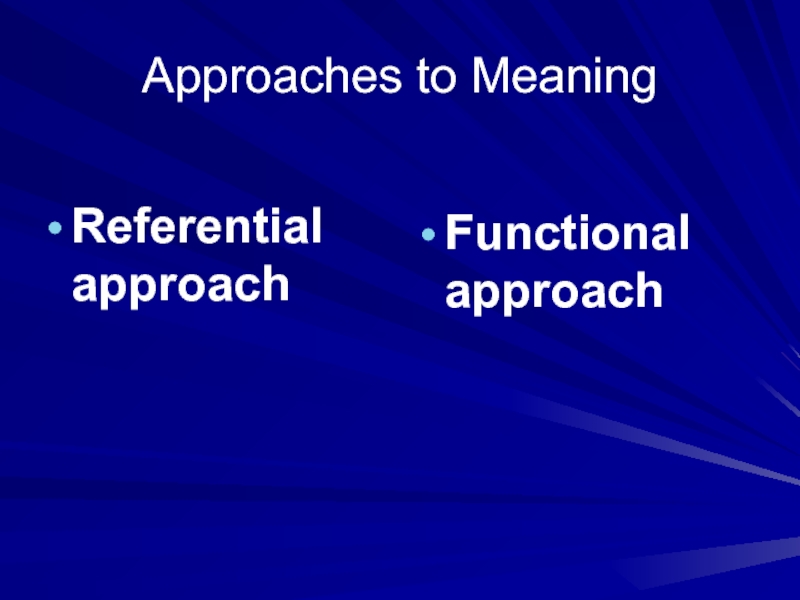
Слайд 4Referential approach to meaning
The meaning is in some form
or other connected with the referent (object of reality denoted
by the word).
The meaning is formulated by establishing the interdependence between words and objects of reality they denote.
The meaning is often understood as an object or phenomenon in the outside world that is referred to by a word.
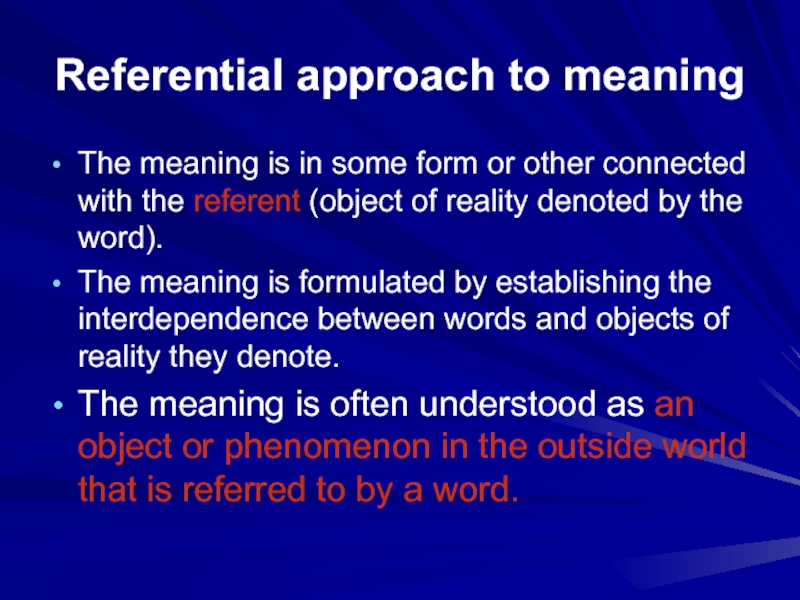
Слайд 5Functional approach to meaning
Words are studied in context; a
word is defined by its functioning within phrase or a
sentence.
The meaning of linguistic unit is studied only through its relation to other linguistic units.
The meaning is viewed as the function of a word in speech.

Слайд 6Concept
a category of human cognition (понятие, идея; общее представление; концепция).
the thought of the object that singles out the most
typical, the most essential features of the object.
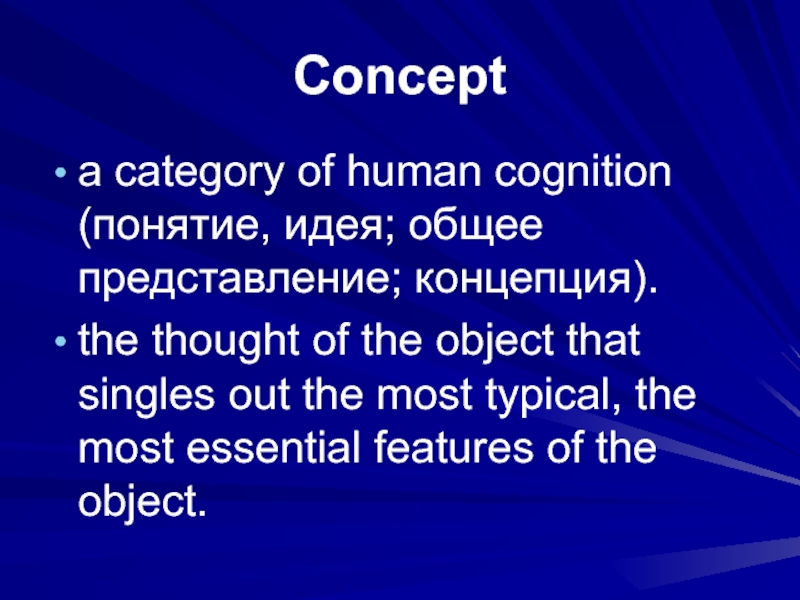
Слайд 7the concept of «a building for human habitation»
English
house
«fixed residence of family or household» −
home
Ukrainian
дім
домівкa
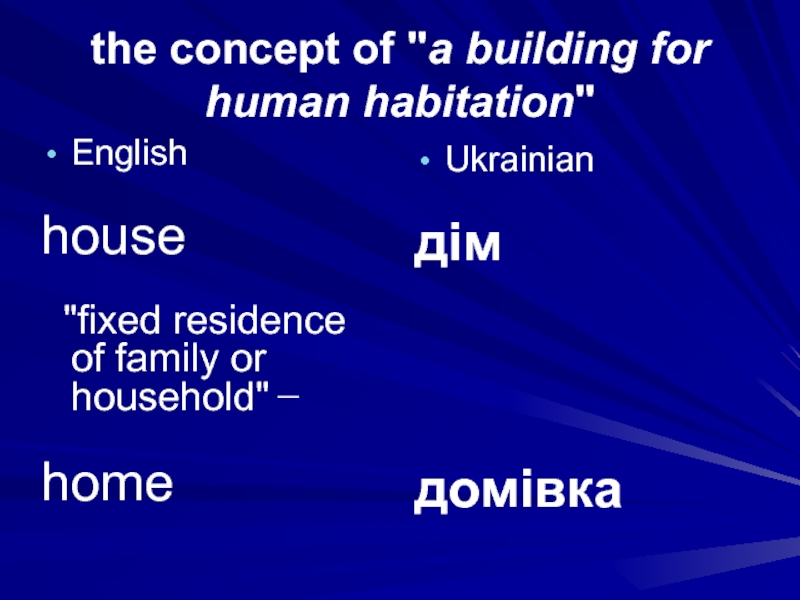
Слайд 8The difference between meaning and concept:
Concepts are always emotionally neutral
Meaning of many words not only conveys some reflection of
objective reality but also the speaker’s attitude to what he is speaking about, his state of mind.
The concept of size: big / large / tremendous
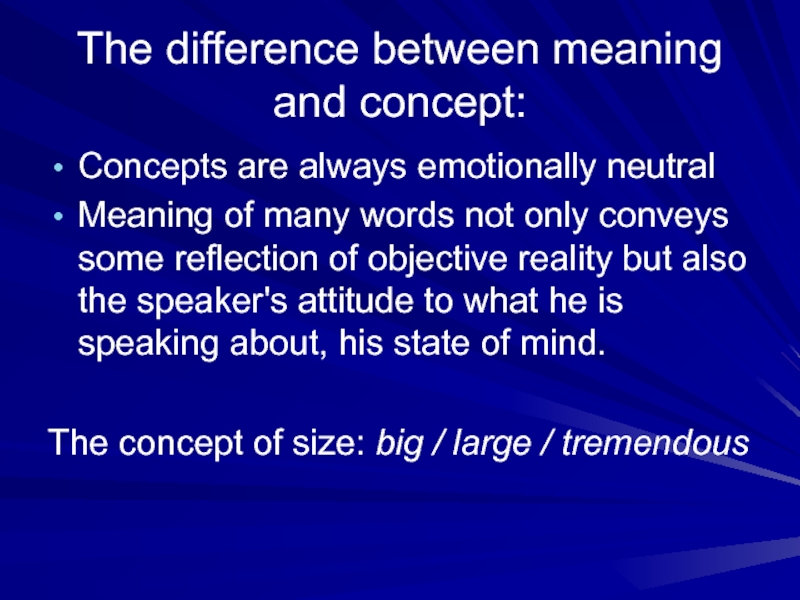
Слайд 9
(thought or reference)
Concept
Word ——————Referent
(symbol)
(object denoted
by the word)

Слайд 10The branch of linguistics which specializes in the study of
meaning is called semantics.
Meaning is a certain reflection in
our mind of objects, phenomena or relations that makes part of the linguistic sign − its so-called inner facet (аспект, грань, сторона), whereas the sound-form functions as its outer facet.
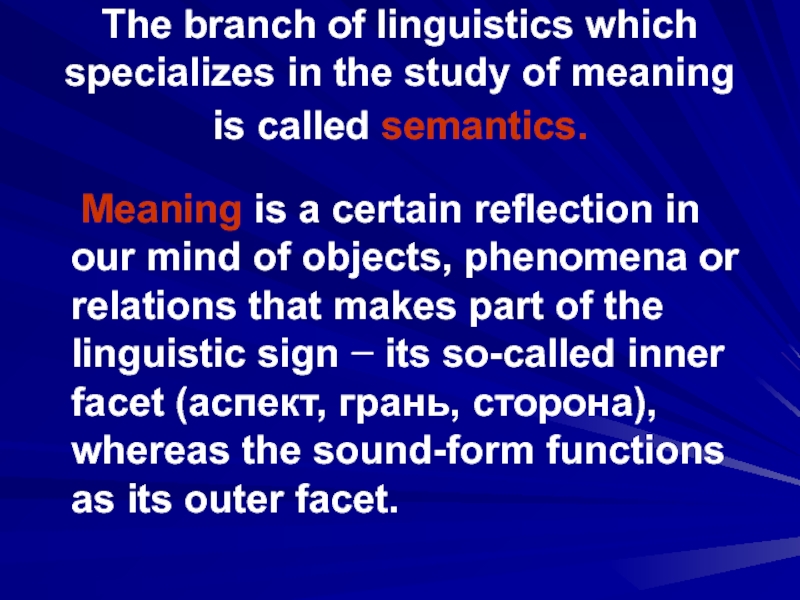
Слайд 11grammatical and lexical meanings
Grammatical meaning − the expression in speech
the relationships between words.
Lexical meaning − the realization of
concept or emotion by means of a definite language system.
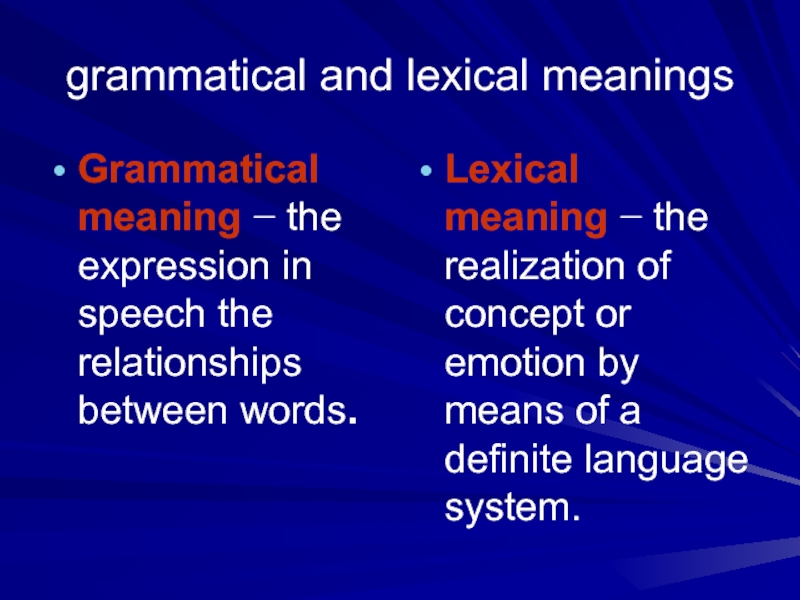
Слайд 12three types of lexical meaning of words:
1. Nominative
meaning determined by reality. The direct nominative meaning stands in
one-to-one relationship with a word. cat, table, sun
2. Phraseologically bound meaning of words depending on the peculiarities of their usage in a given language, e.g. to take care, to have a smoke, to catch a cold.
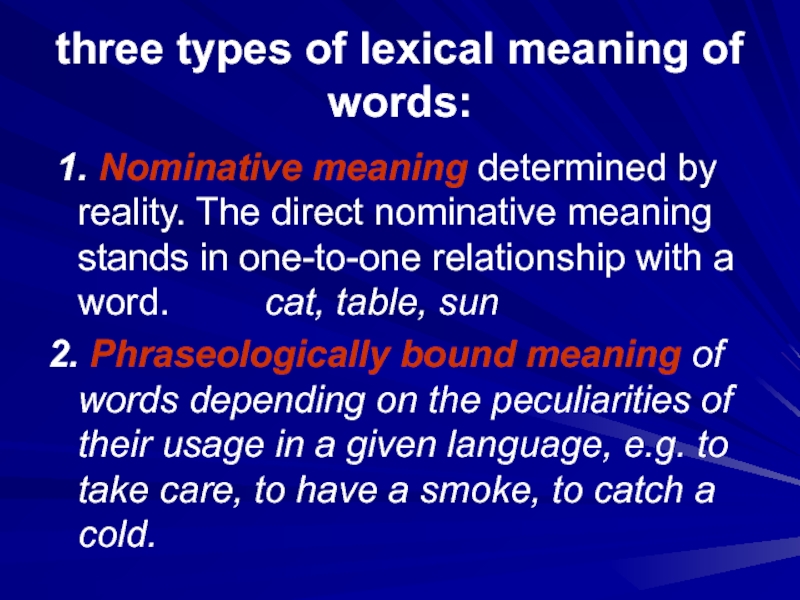
Слайд 13 3. Syntactically conditioned meanings
of words are
those which change with the change of the environment. Compare
the following verbs:
«to look» — to look for— to look after
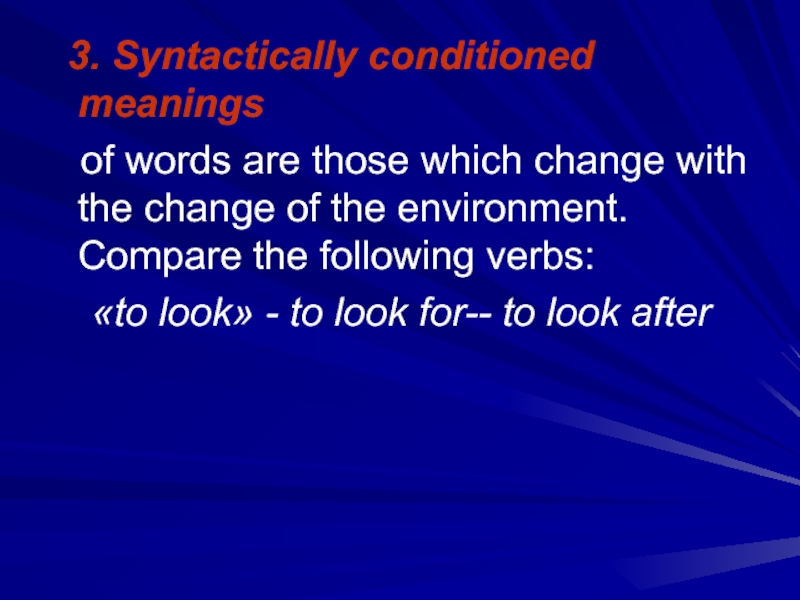
Слайд 14The structure of lexical meaning of a word
denotative
meaning
connotative meaning
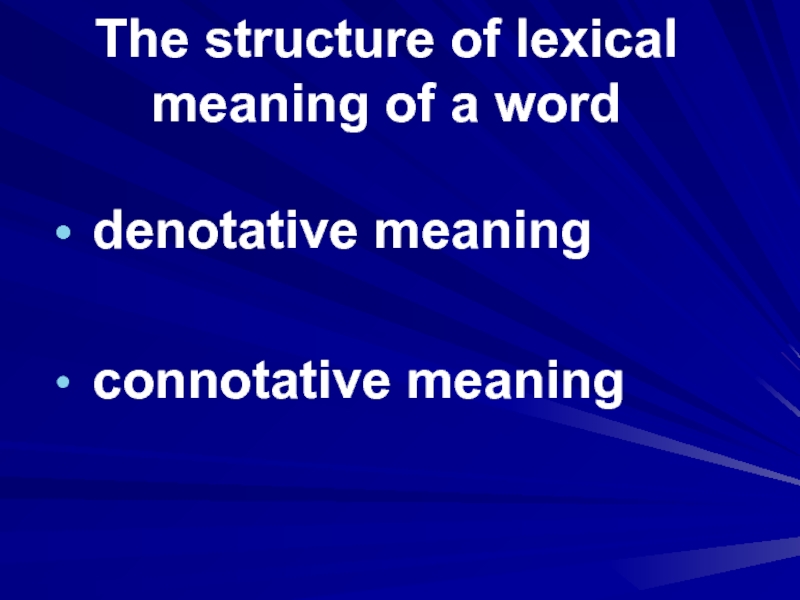
Слайд 15Denotative meaning
a linguistic expression for a concept or a
name for an individual object.
makes communication possible.
is bound up
with its referent.
may have one constant referent – a moon
may have several referents — a hand
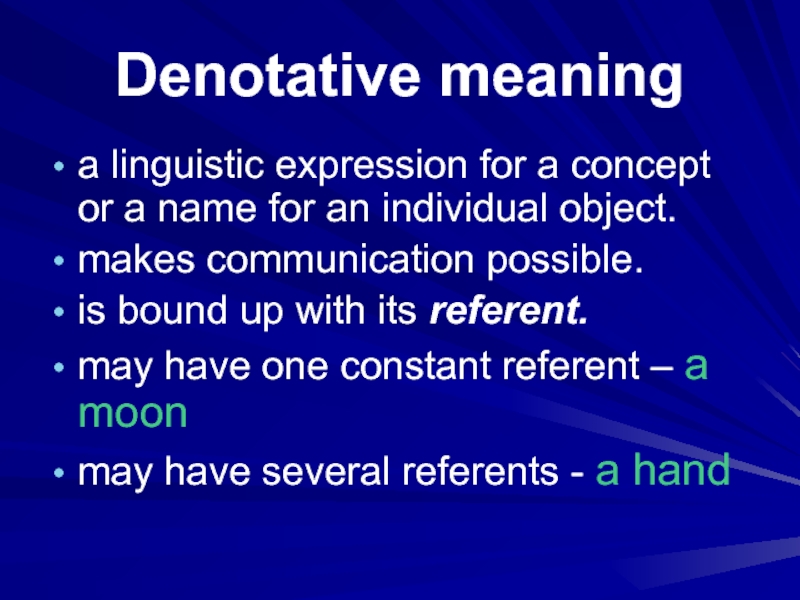
Слайд 16Connotative meaning
additional non-literal meaning of a word.
contains various shades
of meaning called connotations.
connotations reflect subjective, emotional attitude of
people toward object or phenomenon.
is unstable. In most cases it reveals itself only through contexts.
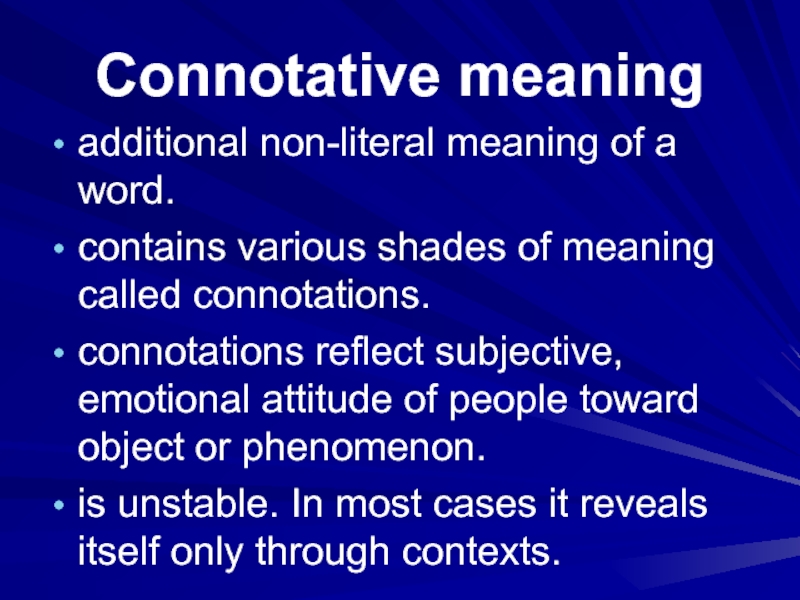
Слайд 17four main types of connotations:
stylistic connotation is what the word
conveys about the speaker’s attitude to the social circumstances and
the appropriate functional style (slay vs kill)
emotional connotation conveys the speaker’s emotions (mummy vs mother)
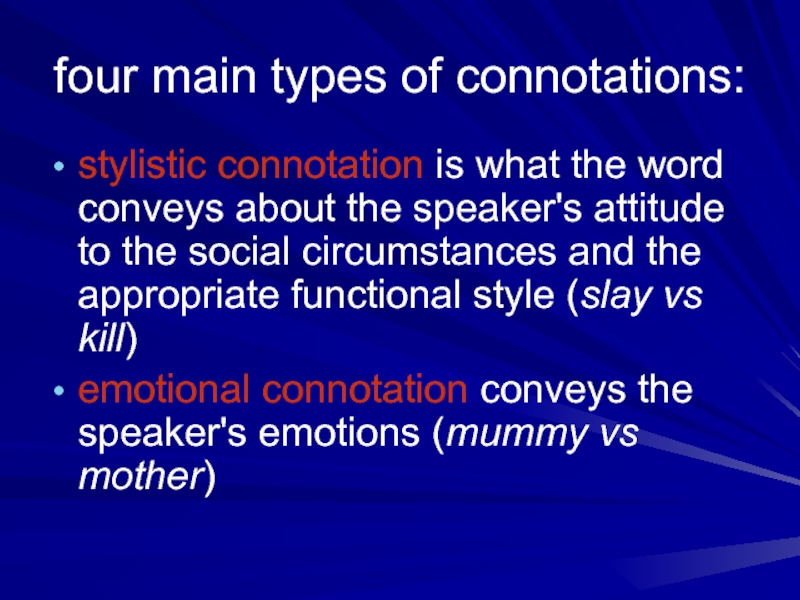
Слайд 18evaluative connotation may show his approval or disapproval of the
object spoken of (clique vs group)
expressive/intensifying connotation is conveyed
by degree of intensity (adore vs love)
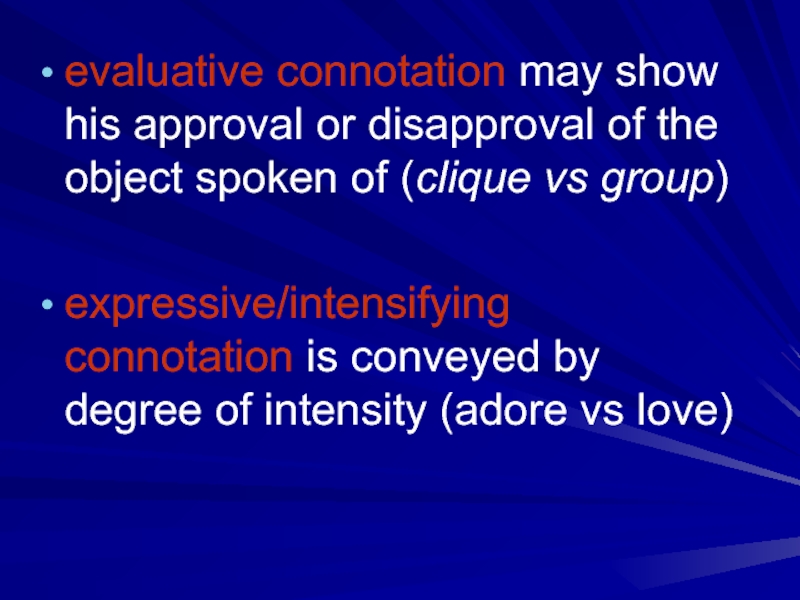
Слайд 19terrific
the denotative component of the lexical meaning of the
word is «frightening“.
the expressive or intensifying connotation is
«very, very good» or «very great»:
terrific beauty, terrific pleasure
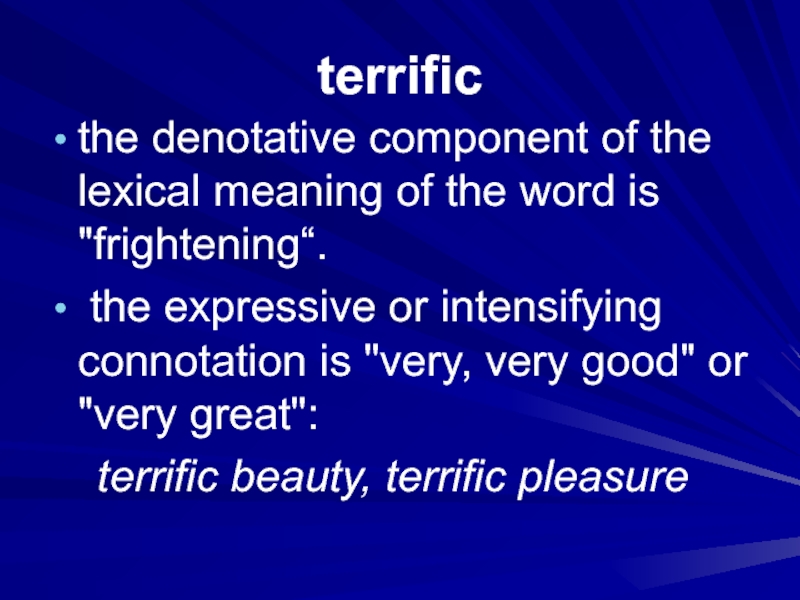
Слайд 20 It is the connotative meaning in a word which
helps create irony, sarcasm, metaphor and other figures of speech.

Слайд 21POLYSEMY
the ability of words to have more than one meaning.
A word having several meanings is called polysemantic and
most English words are like this.
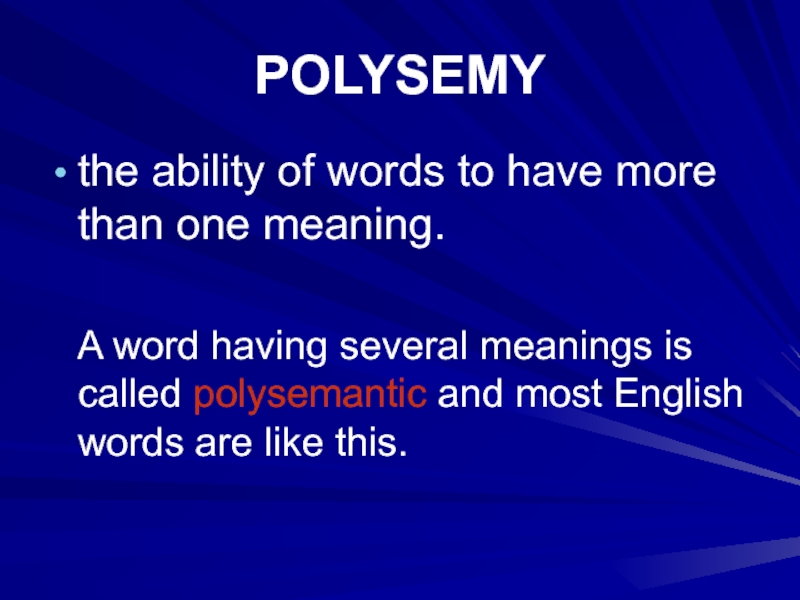
Слайд 22table
1) a flat horizontal slab or board, usually supported by
one or more legs, on which objects may be placed
2)
a) such a slab or board on which food is served we were six at table b) (as modifier) table linen c) (in combination) a tablecloth
3) food as served in a particular household or restaurant
4) such a piece of furniture specially designed for any of various purposes
5) a) a company of persons assembled for a meal, game, etc b) (as modifier) table talk
6) any flat or level area, such as a plateau
7) a rectangular panel set below or above the face of a wall

9) an upper horizontal facet of a cut gem
10) music the sounding board of a violin, guitar, or similar stringed instrument
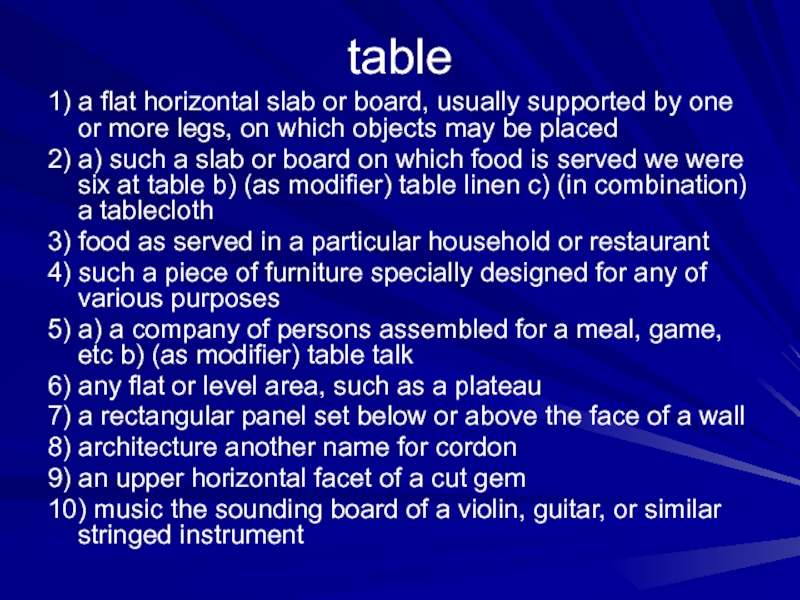
Слайд 23Change of lexical meaning in words
linguistic
— the influence of
linguistic environment
— analogy
— the context
extra-linguistic
— cultural
— social
—
psychological
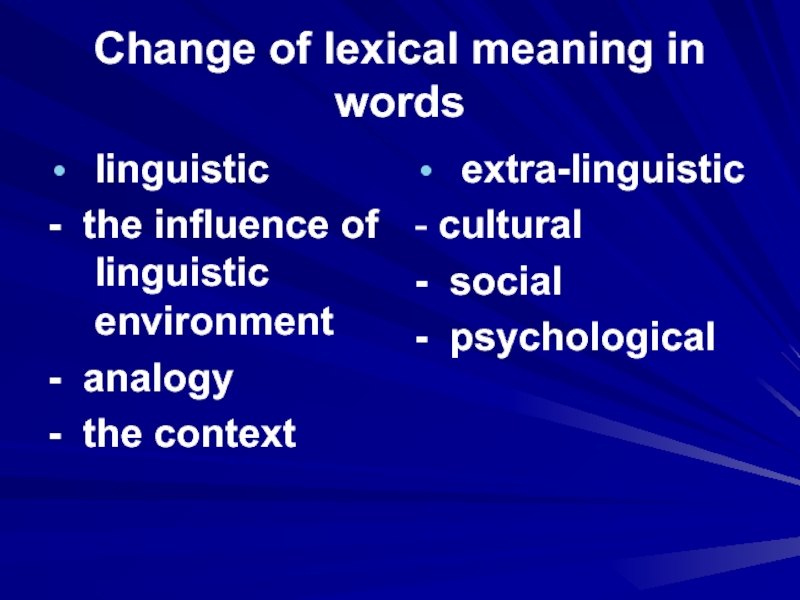
Слайд 24ways of change of word-meaning:
1. extension of meaning (generalization);
2. narrowing
of meaning (specialization);
3. transference of meaning (metaphor and metonymy);
4. elevation
of meaning (amelioration);
5. degradation of meaning (pejoration).

Слайд 251. Extension /expanding of meaning (or generalization).
In the
process of extension a word-meaning may acquire a higher degree
of abstraction or more generalized character.
“manuscript” originally meant only something handwritten. Now it refers to any copy either written by hand or printed.
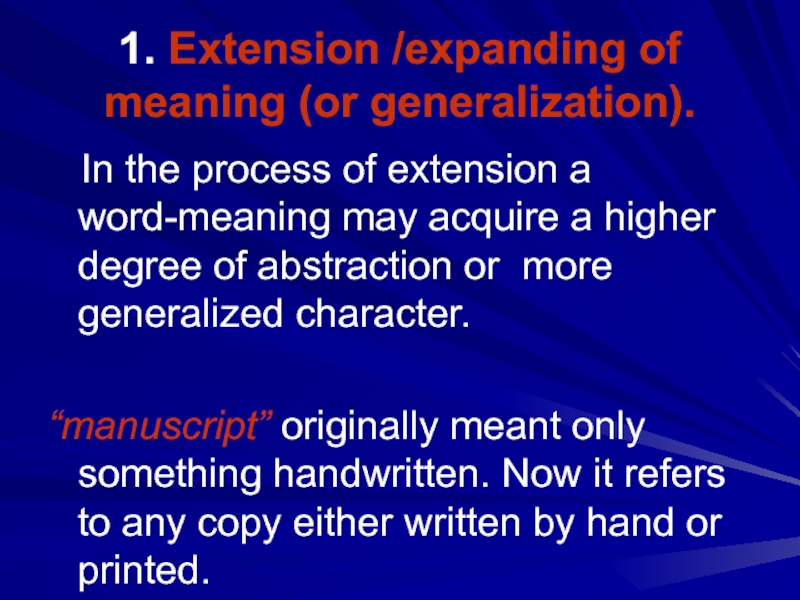
Слайд 262. Narrowing of meaning/contraction, (specialization).
In the process of
narrowing, a word-meaning acquires a specialized sense in which it
is applicable only to some of the objects or phenomena it previously denoted.
a corpse — a human or animal body, living or dead. Now this word has been specialized to mean «a dead body», usually that of a human being.
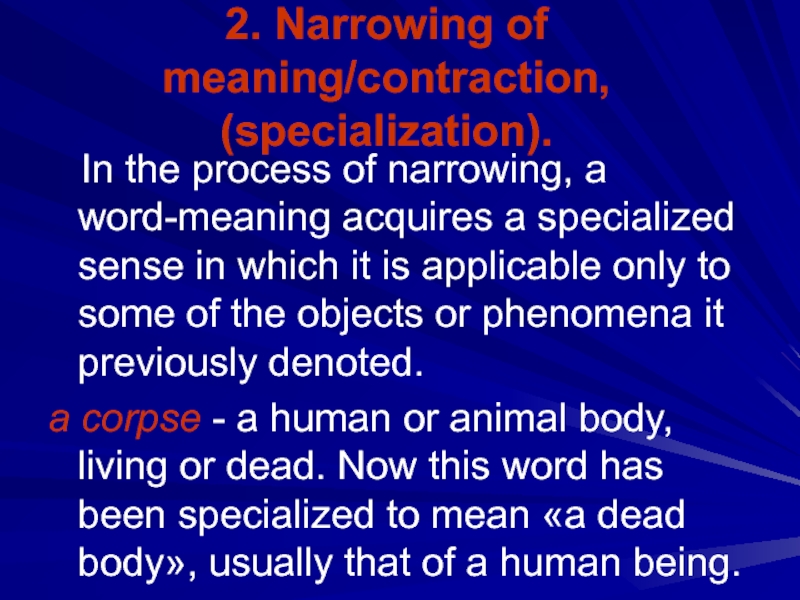
Слайд 273. Elevation of meaning (amelioration )
In the
process of elevation a word acquires the meaning of a
greater importance than its original meaning.
marshal — originally meant a horse servant, now its meaning is «an officer of the highest rank»
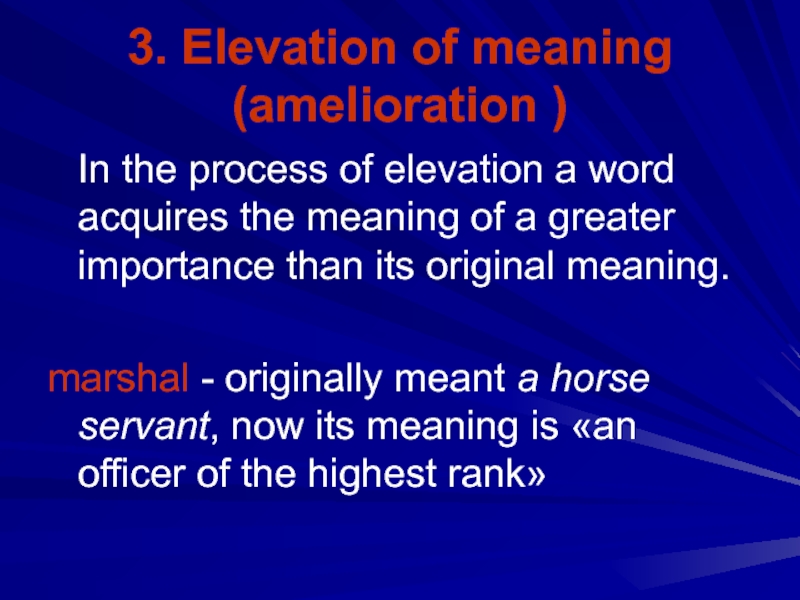
Слайд 284. Degradation of Meaning (degeneration, pejoration).
In the
process of pejoration the word acquires unfavourable connotations or falls
into disrepute.
«vulgar» — originally meant «common, ordinary»;
«gossip» — originally meant «a god parent»;
«silly» — originally meant «happy».
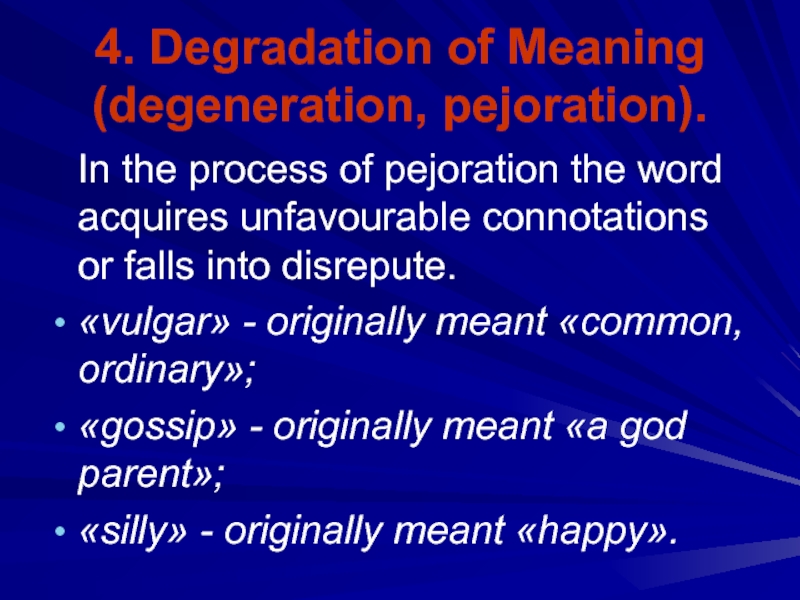
Слайд 295. Transference of meaning.
Transference of meaning takes place when
the figures of speech are used.
Figures
of speech are expressive means and stylistic devices such as metaphor and metonymy.

Слайд 30Metaphor
the transference of the literal meaning in a
word based on the association of similarity between the objects
or phenomena.
a woman can be called «a peach» if she is young and beautiful, or «a lemon» if she is ugly and boring.
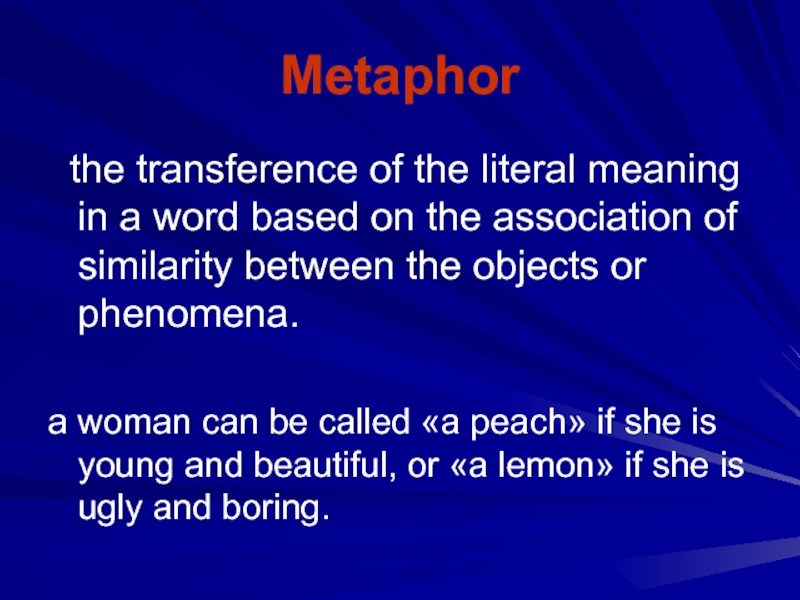
Слайд 31Metonymy
the transference of the literal meaning of a
word based on the association of contiguity between objects or
phenomena.
«cash» is an adaptation of the French word «caisse» which means «box» and in which money was contained. Now the meaning of this word is «money».
«crown» in the meaning of «monarchy»
